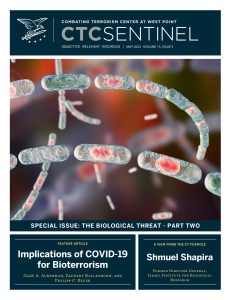From the Editor
With more than a million Americans dead from COVID-19 and the pandemic associated directly or indirectly with around 15 million deaths globally by the end of 2021 according to World Health Organization estimates, it is essential to reassess the global biological threat landscape, including the possibility that bioterrorists or other bad actors might seek to exploit advances in biotechnology to engineer a future pandemic.
In a joint effort, the Combating Terrorism Center and the Department of Chemistry and Life Science at West Point have assembled some of the best and brightest thinkers in the counterterrorism, policy, and scientific communities around the world for their perspectives and analysis on the evolution of the biological threat picture. The result is a two-volume set of special issues, with the second volume being published this month.
In the feature article, Gary Ackerman, Zachary Kallenborn, and Philipp Bleek present a bioterrorism classification schema to evaluate the pandemic’s impact on bioterrorism. They assess that “when it comes to bioterrorism, the pandemic probably has not moved the needle much. Although COVID-19 might encourage apocalyptic cults, some radical environmentalists, some extreme right-wing groups, and some Islamist extremist groups toward biological weapons, most other terrorist groups are more likely to be discouraged. The pandemic has bolstered some terrorists’ bio-related capabilities but in at most modest ways. At the same time, lessons from the COVID-19 experience may both help reduce the consequences of a future attack and heighten perceptions of bioterrorism risk.”
Our interview is with Shmuel Shapira, who served as Director General of the Israel Institute for Biological Research between 2013 and 2021.
Audrey Kurth Cronin argues that “the most significant new risks of [biological] attacks come largely from insider threats by knowledgeable scientists with questionable motives, proxy actors backed by adversarial states, or even those experimenting with new biotechnologies irresponsibly.” She writes that “the old threats of bioterrorism remain, but they are joined by new ones that are falling between the seams of biology and other disciplines, especially engineering, data science, and computer science, and especially at the intersection between molecular biology and artificial intelligence.”
Jaime Yassif argues it is vital to “take action to safeguard the life sciences to prevent biotechnology catastrophe, in addition to bolstering law enforcement and intelligence capabilities to more effectively anticipate and prevent bioterrorism and other biological threats.” She writes: “In biosecurity, there is no single solution or intervention that can eliminate all risk. That is why a layered defense is needed, in which multiple interventions in aggregate add up to substantial risk reduction.”
Paul Cruickshank, Editor in Chief
 Skip to content
Skip to content

